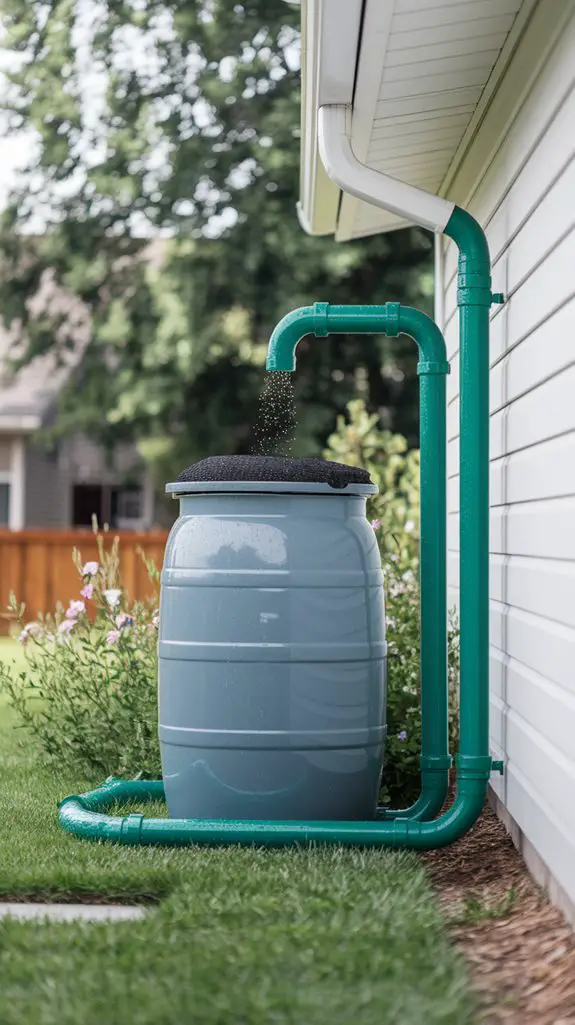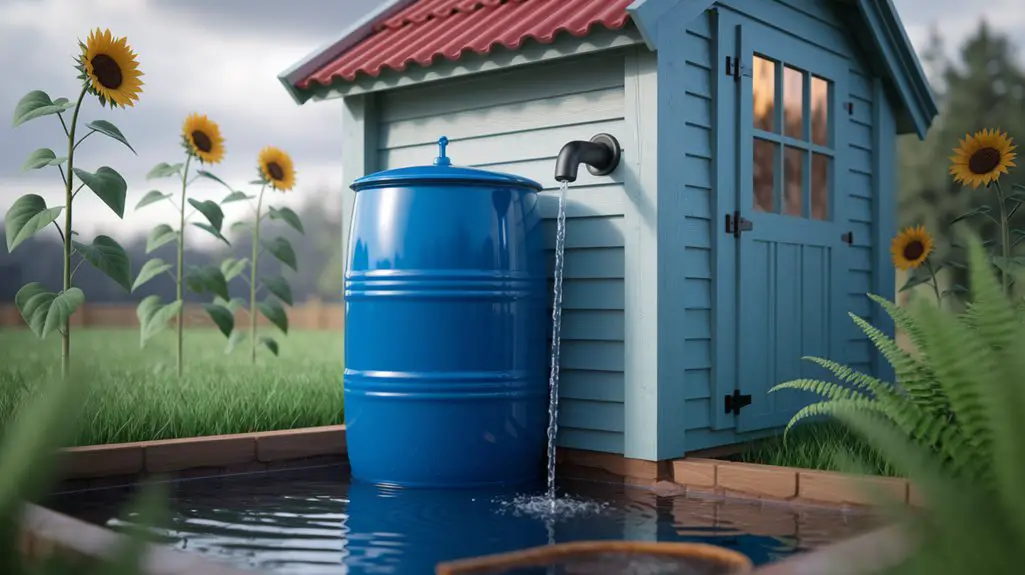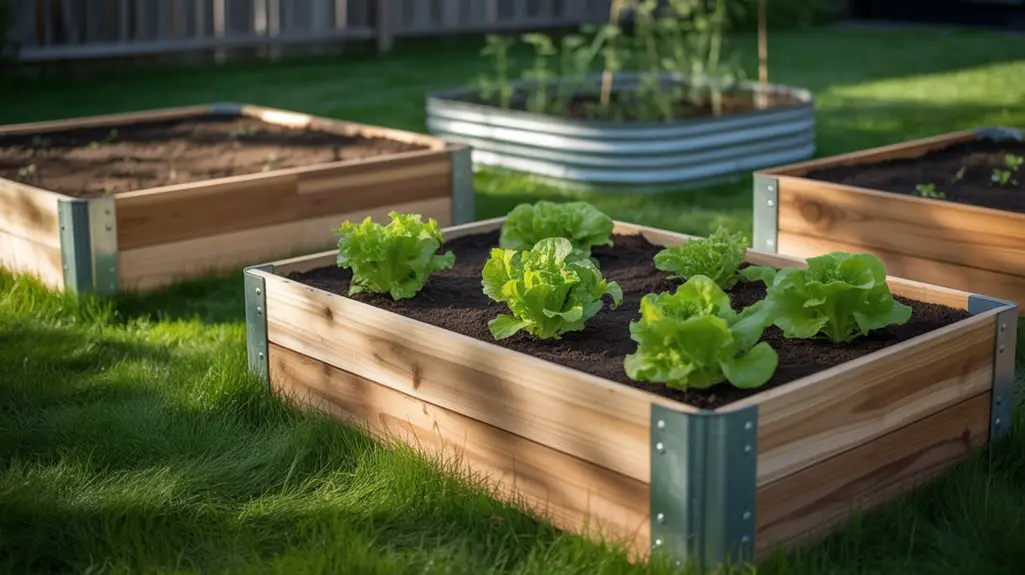Water, like money in a savings account, represents untapped potential falling freely from the sky onto your property. You’ve watched gallons cascade from your roof during rainstorms, wondering if there’s a practical way to capture this resource. A simple rainwater harvesting system can transform this wasted bounty into a valuable asset for your garden and home with minimal investment. The solution requires just a few components and basic tools you likely already own.
Why Harvesting Rainwater Makes Sense for Your Backyard
Whether you’re a gardening enthusiast or simply looking to reduce utility bills, harvesting rainwater provides a practical solution for sustainable water management in your backyard. This approach conserves municipal water supplies while reducing your environmental footprint considerably.
During heavy rainfall, your standard roof can collect approximately 600 gallons of water per 1,000 square feet. Instead of letting this resource drain away, you’ll capture it for irrigation, washing outdoor equipment, or supplementing landscape water features.
Rainwater harvesting also prevents erosion and flooding by managing runoff effectively. It’s particularly valuable during water restrictions, giving you a reliable alternative water source.
Additionally, plants often respond better to rainwater’s neutral pH and lack of chemicals compared to treated municipal water, potentially improving your garden’s health and productivity. Implementing a DIY rainwater harvesting system can further enhance your ability to utilize this natural resource efficiently.
Essential Components for a Basic Collection System

A successful rainwater harvesting setup requires several key components working together as an integrated system.
You’ll need these elements properly sized and connected to guarantee efficient collection, filtration, and storage of precipitation from your roof surface.
- Catchment area – Typically your roof, which should be made of non-toxic materials and regularly cleaned to prevent contamination.
- Conveyance system – Gutters and downspouts that direct water from the catchment area to your storage container.
- First-flush diverter – A mechanism that diverts the initial runoff containing most contaminants away from your storage.
- Storage tank – A food-grade container sized according to your rainfall patterns and water needs, equipped with overflow protection and a secure lid.
Step-by-Step Installation Guide

Installing your rainwater harvesting system requires careful planning and methodical execution to guarantee peak functionality and longevity.
Begin by positioning your storage tank on a level, solid surface near your downspout. Next, install the gutter guard to filter debris, then attach the diverter to your downspout at a height that allows gravity flow to your tank.
Connect the diverter to your tank using food-grade tubing, making certain of a slight downward slope. Install an overflow outlet near the top of your tank to manage excess water.
Add a spigot near the bottom for easy access, sealing all connections with appropriate waterproof sealant.
Test your system by running water through the gutters, checking for leaks or blockages.
Make necessary adjustments before the first rainfall to guarantee peak collection efficiency.
Calculating Your Potential Water Collection
Understanding your potential rainwater harvest requires simple mathematics that empowers informed planning. Your collection capacity depends on catchment area, local rainfall averages, and system efficiency.
To calculate your estimated collection volume:
- Measure your roof’s footprint in square feet (length × width)
- Multiply this area by your region’s average monthly rainfall in inches
- Multiply by 0.623 (conversion factor for gallons per square foot per inch of rain)
- Apply an efficiency factor of 0.8-0.9 to account for system losses
This calculation reveals your theoretical monthly collection in gallons. For example, a 1,500 square foot roof in an area receiving 1 inch of rain could collect approximately 747-840 gallons.
These figures help you properly size storage tanks and anticipate your system’s yield throughout the year.
Maintaining Your Rainwater Harvesting System
Regular maintenance of your rainwater harvesting system guarantees peak performance and extends its operational lifespan. Develop a quarterly schedule to inspect key components and address issues promptly.
| Maintenance Task | Frequency |
|---|---|
| Clean gutters and downspouts | Monthly |
| Inspect filters and screens | Quarterly |
| Check tank for sediment | Bi-annually |
| Sanitize storage tank | Annually |
| Examine pump functionality | Quarterly |
During dry seasons, empty and clean your storage tank to prevent algae growth. Apply food-grade hydrogen peroxide (1 cup per 1,000 gallons) to sanitize the system. Inspect first-flush diverters quarterly, removing accumulated debris that can compromise water quality. Replace filters according to manufacturer specifications or when you notice reduced flow. Document all maintenance activities to track system performance and identify recurring issues requiring permanent solutions. Additionally, integrating rainwater harvesting into your outdoor water features can enhance sustainability and reduce reliance on municipal sources.
Creative Ways to Use Your Harvested Water
Beyond conventional irrigation, harvested rainwater offers dozens of practical applications throughout your property. When properly filtered, this sustainable resource can supplement multiple household systems while reducing your dependence on municipal supplies.
- Laundry Integration – Connect your harvesting system to your washing machine, reducing mineral buildup in both your clothes and appliance.
- Livestock Watering – Implement automatic drinking stations for animals using gravity-fed systems from elevated tanks.
- Decorative Water Features – Power fountains or ponds using solar pumps that circulate harvested water through biofilters.
- Emergency Preparedness – Install a two-stage filtration system with UV treatment to create potable water reserves during service disruptions.
In addition to these uses, consider that seasonal tips for rainwater harvesting can help you optimize your collection and storage methods for maximum efficiency.
You’ll maximize system efficiency by implementing multiple use cases, creating redundancy while ensuring your harvested resource serves year-round functions.
Troubleshooting Common Issues in DIY Systems
Even well-designed rainwater harvesting systems eventually encounter operational challenges that require swift intervention. You’ll need to address these issues promptly to maintain collection efficiency and water quality. Incorporating rainwater collection techniques can also help mitigate some of these common problems.
| Issue | Cause | Solution |
|---|---|---|
| Clogged gutters | Leaf/debris buildup | Install gutter guards; clean quarterly |
| Stagnant water | Poor circulation | Add small pump; guarantee proper slope |
| Algae growth | Sunlight exposure | Cover tank; add food-grade hydrogen peroxide |
| Mosquito breeding | Unscreened openings | Seal all entry points; add mosquito dunks |
| Low pressure | Insufficient elevation | Raise tank or install pressure pump |
When your system’s flow rate decreases, first check filters before assuming pipe blockage. Remove first-flush diverters seasonally to clear sediment accumulation. For persistent leaks at connection points, replace washers and apply food-grade silicone sealant where appropriate.
Conclusion
You’ve now mastered the laughably simple art of collecting what literally falls from the sky. Congratulations on your revolutionary achievement! Your neighbors will remain shackled to their water bills while you’ve engineered a hydration liberation system that’ll function perfectly—until it doesn’t. When your tank overflows or algae colonizes your supply, just remember: you’re not experiencing problems, you’re encountering “advanced learning opportunities” in your water sovereignty journey.




